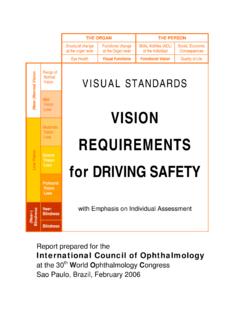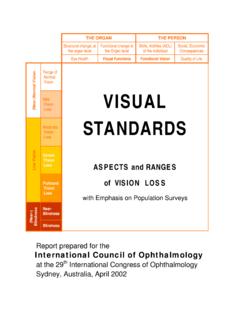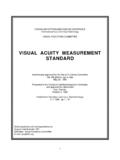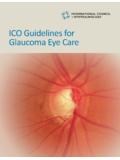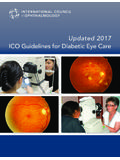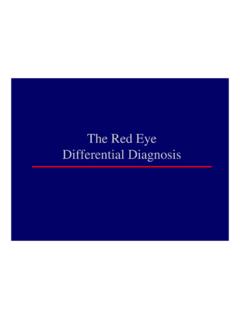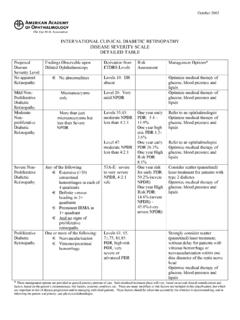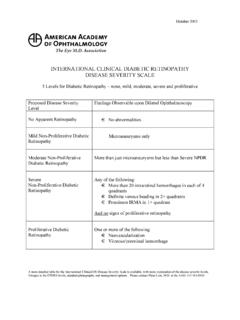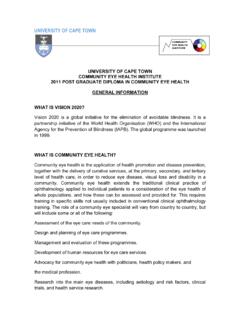Transcription of VISION REQUIREMENTS for DRIVING SAFETY
1 THE ORGAN THE PERSON Structural change at the organ level Functional change at the Organ level Skills, Abilities (ADL) of the individual Social, Economic Consequences Eye Health Visual Functions Functional VISION Quality of Life Range of Normal VISION (Near-)Normal VISION Mild VISION Loss Moderate VISION Loss Severe VISION Loss Low VISION Profound VISION Loss Near- Blindness (Near-) Blindness Blindness VISUAL STANDARDS VISION REQUIREMENTS for DRIVING SAFETY with Emphasis on Individual assessment report prepared for the International Council of Ophthalmology at the 30th World Ophthalmology Congress Sao Paulo, Brazil, February 2006 TABLE of CONTENTS Sections 1 Executive Summary Page 2 2 Preamble 4 3 VISION Loss and DRIVING SAFETY 6 4 Which Visual Functions might be tested?
2 10 5 Suggested Criteria and Rules 13 6 Summary and Recommendations 16 Appendices 1 Survey of DRIVING License REQUIREMENTS (except USA) 17 2 Survey of DRIVING License REQUIREMENTS in the USA 19 3 Suggestions for additional Tests 22 References 24 Please direct COMMENTS to the authors: August Colenbrander, MD Affiliate Senior Scientist, Smith-Kettlewell Eye Research Institute, San Francisco Director Emeritus, Low VISION Services, California Pacific Medical Center Correspondence: 664 Atherton Avenue Novato, CA 94945-2605 USA E-mail: Phone: +1-415-209-9529 Prof.
3 Dr. Jean-Jacques De Laey, MD Chairman, Dept. of Ophthalmology, University of Ghent, Belgium Correspondence: Dept. of Ophthalmology, University Hospital De Pintelaan 185 B9000 Gent, Belgium E-mail: Phone: +32-9-240-2319 The report can be downloaded in PDF FORMAT from the website of the International Council of Ophthalmology: 1 VISION REQUIREMENTS for DRIVING SAFETY International Councill of Ophthalmology December, 2005 SECTION 1 EXECUTIVE SUMMARY Section 2 Preamble In 2002 the International Council of Ophthalmology (ICO) issued a report , discussing Visual Standards, aspects and Ranges of VISION Loss with Emphasis on Population Surveys [ ]1.
4 The current report addresses individual assessment of visual functions and their relation to functional VISION in the context of VISION REQUIREMENTS for DRIVING SAFETY . The purpose of this report is not to provide a set of uniform rules that can be implemented unchanged in any jurisdiction. Rather, it is aimed at providing a set of considerations for use by any group contemplating the development or refinement of DRIVING license REQUIREMENTS . The 2002 ICO report distinguished several aspects of VISION loss, notably Visual Functions, which describe how the eye functions and Functional VISION , which describes how the person functions in VISION -related activities. For each of these aspects , various ranges of functioning can be identified, ranging from normal functioning, over mild, moderate, severe and profound loss to total loss. The traditional, simplistic, black-and-white distinction between those who are sighted and those who are blind is not tenable.
5 A 2002 resolution by the International Federation of Ophthalmolological Societies denounced the use of the word blindness for those who have useable residual VISION [1]. The relationship between visual functions and functional VISION is complex and can be influenced by many factors. While population statistics may define average performance, individual functioning, as will be discussed in this report , can be considerably better or considerably worse than the statistical average. Traditional clinical tests determine a performance threshold. Real-life performance requires sustainable, supra-threshold performance. Establishing DRIVING license criteria therefore is an exercise in establishing a SAFETY margin between performance on clinical tests and performance in actual traffic, rather than a cut-off value between competence and incompetence.
6 Ultimately, DRIVING SAFETY does not depend so much on what is seen, but rather on how quickly and how adequately drivers respond to what is seen. Section 3 VISION Loss and DRIVING SAFETY In our society losing one s DRIVING license has major social consequences. VISION is the most important source of information during DRIVING and many DRIVING related injuries have been associated with visual problems. Visual assessment for DRIVING is thus a major health issue. This paper was developed to explore ways in which the ICO could contribute towards global harmonization in this important area. It lists many sensitive questions. A literature review shows that there is a relationship between the SAFETY margin established by VISION -related DRIVING license REQUIREMENTS and actual DRIVING performance, but that this relationship is generally weak.
7 2 VISION REQUIREMENTS for DRIVING SAFETY International Councill of Ophthalmology December, 2005 Section 4 Which Visual Functions might be tested? This section discusses various visual functions, among them: Visual acuity, which is commonly tested. Contrast sensitivity, which is significant, but rarely tested. Visual field, for which REQUIREMENTS vary and testing methods are rarely specified. Other visual functions include: glare sensitivity, Useful Field of View (UFOV), diplopia, color VISION and night VISION . A survey of current REQUIREMENTS can be found in Appendix 1 and 2. Section 5 Suggested Criteria and Rules This section discusses suggested criteria and rules.
8 It stresses the need for binocular (both eyes open) measurements and the need for a gray zone in which decisions will be based on individual consideration, rather than on the application of strict numerical criteria. It also stresses the interaction of visual and non-visual parameters. For visual acuity the commonly used threshold of 20/40 ( , 6/12) is accepted. For visual fields a binocular field of at least 120 horizontal and 40 vertical is suggested. Contrast sensitivity screening is listed as desirable. The use of restricted licenses is advocated. Periodic renewal is advocated, especially for older subjects. Section 6 Summary and Recommendations This section summarizes the recommendations. Appendix 1 Survey of DRIVING License REQUIREMENTS in various countries, except the USA Appendix 2 Survey of DRIVING License REQUIREMENTS in various states in the USA Appendix 3 Suggestions for Additional Tests Traditional clinical test were developed and refined to facilitate the diagnosis of underlying disorders.
9 They generally measure threshold performance for a single parameter in a static environment. This section list some suggestions for non-traditional tests, aimed at estimating functional performance. They may assess several parameters in one test and consider reaction speed in a timed environment 3 VISION REQUIREMENTS for DRIVING SAFETY International Councill of Ophthalmology December, 2005 SECTION 2 PREAMBLE A previous report , prepared for the International Council of Ophthalmology, discussed Visual Standards, aspects and Ranges of VISION Loss with Emphasis on Population Surveys [1]. In such surveys statistical averaging smoothes out the differences between individuals.
10 The current report addresses Individual assessment in the context of VISION REQUIREMENTS for DRIVING SAFETY . It is appropriate to start this report with several caveats. To discuss the relations between DRIVING performance and various parameters of visual function, it is helpful to recognize the four aspects of functioning used in ICIDH [ ]2 and ICF [ ]3. Of these aspects , two describe how organs or body systems function; two describe how the person functions. In the field of VISION , we use Visual Functions to describe how the eye functions and Functional VISION to describe how the person functions in VISION -related activities [ ]4. Table 1 shows various links; these links are not fixed, since for each link there are multiple causal factors and therefore multiple possible outcomes. The bottom part of the diagram shows the application of these principles to DRIVING -related functioning.
